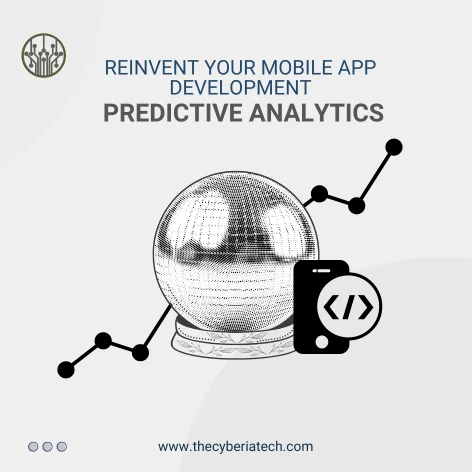App development has exciting parts, and predictive analytics is one of them. It uses advanced data analysis techniques to make accurate predictions and help make better decisions within applications.
Predicting future outcomes and trends involves analyzing patterns in historical data using statistical models. App developers can use predictive analytics to create intelligent apps that predict user behavior, improve processes, and provide customized experiences. Let’s dig deeper into it.
What Is Predictive Analytics?
Predictive analytics is a helpful tool that uses data analysis to predict future events. These rely on past information and use statistical modeling and machine learning to analyze data. Predictive analytics is a scientific method that can accurately predict future outcomes.

Using predictive data analytics tools and models, businesses can analyze past and current data to make reliable predictions about future trends to bring a higher quality user experience.
Many organizations are using predictive analytics software, and it’s becoming increasingly popular. The global market size for this software is predicted to reach $38 billion in 2028. This method can help you better understand and make informed decisions for your business.
Predictive analytic Models
Tools for predictive data analytics use various models and algorithms that can be used for many different purposes. Choosing the proper predictive modeling techniques is essential for your business to make informed decisions based on data. Here are 4 popular predictive analytics models you can check out:
- Clustering Model
As its name shows, it organizes information into groups based on similar characteristics, each containing subgroups. Businesses can use the clustering model to group customers based on shared characteristics. This helps them to do it quickly and efficiently. It assists in creating better plans for each group primarily.
- Classification model
Predictive analytics uses a classification model to sort data into different categories based on what it has learned from past data. This model is great for answering simple yes or no questions and can provide a helpful analysis to guide decision-making.
- Forecast model
Predictive numerical values are one of the widely used models. It predicts data based on what has been learned from past historical data.
- Time series model
It is a series of data lines that use time as the input parameter. The time series model looks at the data from the past year and uses it to predict the next three to six weeks. It does this by creating a number that helps with the forecast.

How Does Predictive Analytics Work?
The process is a futuristic prediction. Consider predictive analytics forecasting; these predictions are combined with metrologists using atmospheric data. Artificial intelligence, analysis, data, and ML are all used as the ingredients of predictive analysis.
As a result, it saves time, cuts cost, and increase employee retention. So, Predictive analytics is all about optimizing user experience in any case. Let’s see each step of this process:
- Clarifying the issue
The first step of each prediction starts with a list of criteria and a strong thesis. And start asking questions; can a model predicts outcomes? To choose the right predictive analytics method, it’s essential to have an apparent problem to solve.
Getting The Data And Structuring It
In this step, we have to consider that data flows are identified before developing the predictive analytic models.
Developing Predictive Models
Data scientists can use various tools and approaches to create predictive models depending on the problem to be solved and the dataset’s characteristics. One of the most popular predictive models is regression modeling, also known as machine learning.
Preparing Data
Pay attention to the Anomalies, extreme outliers, and missing data points. They should be removed from the data before it is ready for predictive data analytics models. They might be the outcome of measurement or input errors.

Validate And Implement Your Models
Don’t forget to check the accuracy and make the necessary adjustments. They are fitting the model’s accuracy and making the required adjustments. The stakeholders should be informed of the results via a website, app, or dashboard once they find them acceptable.
How Can Predictive Analytics Be Used In Mobile App Development?
Predictive analytics in app development can help answer questions like “What might happen next?” or “What actions should be taken based on past data?” This technology allows developers to create apps that do more than report data.
They can actively give users insights and recommendations. Predictive analytics can help app developers improve the user experience and grow their business by suggesting relevant products, predicting customer preferences, and optimizing workflows.
Applications for predictive analytics in mobile app development can change how the program functions for the intended users. For instance, if you developed a gaming app, the information gathered from the players can be used to improve the app and determine how frequently users access it.

Predictive analytics is a terrific method to bring more clarity and insight to help you make wise business decisions when used with mobile apps. Here are a few examples of how predictive analysis is applied to the creation of mobile applications to increase their effectiveness.
Predictive Planning
You can use predictive data analytics in mobile app development to identify and fix repetitive mistakes that could cause bugs. It can also assist in analyzing the total number of code lines developed by the developers. The Predictive Analytics app can help you determine if your business can meet a specific delivery date.
DevOps Tools
This tool combines mobile app development and operations to help speed up the delivery of mobile applications. It’s an open source DevOps tool.
If the production data is shared with the development team, they can use predictive data analysis for mobile apps to identify the coding process that is causing a bad user experience for consumers.
Predictive Analytics
Mobile app performance testing encompasses a testing approach that seeks to anticipate and forecast the behavior and functionality of a system or product across different conditions. Specifically focused on mobile apps, this predictive testing method aims to ensure optimal performance, seamless user experience, and reliable functionality.
Instead of testing every possible user interface combination, predictive analytics can be used to identify commonly used paths taken by users.
How does Predictive Analytics Impact Mobile App Development?
Businesses can use predictive analytics in many ways. Improving mobile app experience and effectiveness is made possible with this. Check out these points that explain how predictive data analytics affects mobile app development:

You may be wondering where to start with your prediction efforts. In an article about Salesforce Predictive Analytics, we have explained how the tech giant can help you form a predictive analysis strategy.
Customized Marketing
It’s great to see how many businesses are using mobile data analytics to attract customers. By using predictive analytics in your mobile apps, you can easily give users personalized messages and tailored listings. It makes the experience even more personalized.
How To Improve User Retention
Applications that use predictive analysis can help improve user retention significantly. This tool assists businesses in understanding how customers use their app and the different ways they want to interact with it.
Predictive analytics can help businesses identify and fix problems and enhance features that appeal to customers.
Make Use Of Information About Customer Behavior
Using predictive data analytics in mobile apps can help businesses understand consumers’ behavior. When consumers choose certain products or services, it helps entrepreneurs understand what consumers like. Studying the data helps businesses to better focus on their target market.
Determining The Appropriate Time To Switch Devices
When predictive analytics are implemented well in mobile apps, businesses can gain insights into the types of devices that consumers are using while using the app. This information is very important for the technical team because it will help them design the app based on what the target audience likes.
Predictive Analysis Examples
- Netflix
Netflix has improved its services by using user data and preferences such as favorite genres, viewing history, and language to provide personalized recommendations to its users. Did you know that over 80% of the content people watch on Netflix is recommended to them? That’s how effective their viewing recommendations are!
- Siri
Good news! The latest survey shows that 93% of people are happy with their voice assistants. Siri is a popular voice assistant that uses predictive analytics to help its users. The app’s recommendations are based on your previous searches and history. Most users, about 81%, are happy with the app assistant.

Spotify
Spotify has improved user engagement by using predictive analytics in its app through different campaigns. Spotify has a cool campaign called the ‘Wrapped Campaign’ where they give users a summary of their listening habits at the end of the year. Spotify gives users something valuable in return for their data.
Frequently Asked Questions
What are examples of predictive analytics?
By revealing that consumers often use more electricity in the winter, predictive analytics might assist an energy supplier in anticipating consumer worries about their costs.
What uses predictive analytics?
Many companies rely on predictive models for tasks like resource and inventory management. Airlines employ predictive analytics to set ticket prices. To optimize occupancy and revenue, hotels consistently try to provide the most accurate nightly guest count projections possible. Predictive analytics boosts a company’s productivity.
Final Thoughts
One of the key benefits of predictive analytics is its capacity to improve prediction accuracy and precision. It helps organizations make decisions based on data, use resources efficiently, improve customer experience, and reduce risks.
By using advanced analytics, businesses can stay ahead of the competition, come up with new ideas, and achieve long-term success in today’s fast-changing and highly competitive world.







